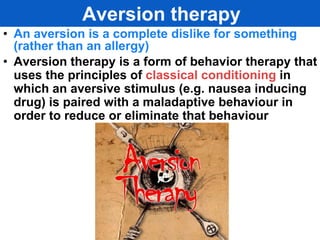Aversion therapy - VCE U4 Psych
•Download as PPTX, PDF•
9 likes•8,695 views
This file accompanies a youtube clip made on this topic. It includes an overview of Aversion therapy and 2 practical examples. see www.ePsychVCE.com for more VCE Psychology resources.
Report
Share
Report
Share

Recommended
Recommended
More Related Content
What's hot
What's hot (20)
Supportive psychotherapy, family and marital therapy

Supportive psychotherapy, family and marital therapy
More from Andrew Scott
More from Andrew Scott (18)
VCE U4 Psychology - Brain mechanisms involved in learning

VCE U4 Psychology - Brain mechanisms involved in learning
Recently uploaded
https://app.box.com/s/4hfk1xwgxnova7f4dm37birdzflj806wGIÁO ÁN DẠY THÊM (KẾ HOẠCH BÀI BUỔI 2) - TIẾNG ANH 8 GLOBAL SUCCESS (2 CỘT) N...

GIÁO ÁN DẠY THÊM (KẾ HOẠCH BÀI BUỔI 2) - TIẾNG ANH 8 GLOBAL SUCCESS (2 CỘT) N...Nguyen Thanh Tu Collection
This slide is prepared for master's students (MIFB & MIBS) UUM. May it be useful to all.Chapter 3 - Islamic Banking Products and Services.pptx

Chapter 3 - Islamic Banking Products and Services.pptxMohd Adib Abd Muin, Senior Lecturer at Universiti Utara Malaysia
Recently uploaded (20)
Instructions for Submissions thorugh G- Classroom.pptx

Instructions for Submissions thorugh G- Classroom.pptx
GIÁO ÁN DẠY THÊM (KẾ HOẠCH BÀI BUỔI 2) - TIẾNG ANH 8 GLOBAL SUCCESS (2 CỘT) N...

GIÁO ÁN DẠY THÊM (KẾ HOẠCH BÀI BUỔI 2) - TIẾNG ANH 8 GLOBAL SUCCESS (2 CỘT) N...
Sectors of the Indian Economy - Class 10 Study Notes pdf

Sectors of the Indian Economy - Class 10 Study Notes pdf
Chapter 3 - Islamic Banking Products and Services.pptx

Chapter 3 - Islamic Banking Products and Services.pptx
MARUTI SUZUKI- A Successful Joint Venture in India.pptx

MARUTI SUZUKI- A Successful Joint Venture in India.pptx
Jose-Rizal-and-Philippine-Nationalism-National-Symbol-2.pptx

Jose-Rizal-and-Philippine-Nationalism-National-Symbol-2.pptx
Solid waste management & Types of Basic civil Engineering notes by DJ Sir.pptx

Solid waste management & Types of Basic civil Engineering notes by DJ Sir.pptx
Basic phrases for greeting and assisting costumers

Basic phrases for greeting and assisting costumers
The Art Pastor's Guide to Sabbath | Steve Thomason

The Art Pastor's Guide to Sabbath | Steve Thomason
Industrial Training Report- AKTU Industrial Training Report

Industrial Training Report- AKTU Industrial Training Report
Aversion therapy - VCE U4 Psych
- 1. Aversion therapy • An aversion is a complete dislike for something (rather than an allergy) • Aversion therapy is a form of behavior therapy that uses the principles of classical conditioning in which an aversive stimulus (e.g. nausea inducing drug) is paired with a maladaptive behaviour in order to reduce or eliminate that behaviour
- 2. Aversion therapy • Used for treating • Homosexuality • Sexually deviant children • Addictions e.g. Smoking, alcoholism • Bad habits
- 3. Aversion therapy • E.g. Smokers given electric shocks (UCS) when they see/ smell a cigarette (originally the NS) i.e. cigarettes paired with electric shocks; the electric shocks reflexively cause pain (UCR) • After several pairings, even the sight or smell of cigarettes (CS) leads to a negative emotional response (CR) i.e. an aversion
- 4. Solution – to example Baseline NS: Cigarettes evokes stage No aversive response UCS: Electric Shocks evokes UCR: Pain & anxiety Acquisition Repeated pairings of stage NS (Cigarettes) & UCS (electric shocks) evoking UCR (pain & anxiety) Post CS: Thought of Cigarettes evokes
- 5. Aversion therapy • E.g # 2. Internet addiction • Required: Describe the process in terms of the 3 stages of Classical Conditioning
- 6. Solution – to examples # 2 Baseline stage Acquisition stage Post Conditioning
- 7. Solution – to example # 2 Baseline NS: Playing on the Internet evokes stage No aversive response UCS: Electric Shocks evokes UCR: Pain & anxiety Acquisition Repeated pairings of stage NS (Internet activity) & UCS (electric shocks) evoking UCR (pain & anxiety) Post CS: Thought of internet evokes
- 8. Limitations of aversion therapy • Ethical considerations i.e. causing physical or psychological pain to patient • Overgeneralisation i.e. avoiding drinking of all types of liquid rather than merely alcohol • Extinction often occurs without repeated administrations of UCS & CS pairing i.e. the • Aversion might not materialise unless they know UCS (nausea inducing drug) will coincide with alcohol consumption
